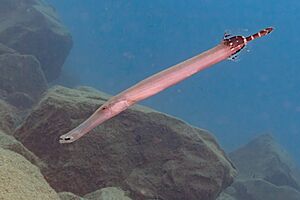Atlantic trumpetfish facts for kids
Quick facts for kids Atlantic trumpetfish |
|
|---|---|
 |
|
| Atlantic trumpetfish on Tenerife (Spain) | |
| Conservation status | |
| Scientific classification |
The Atlantic trumpetfish (Aulostomus strigosus) is a cool fish that looks a bit like a trumpet! It's also called the Atlantic coronetfish. This fish lives in warm ocean waters, usually near the coast in the eastern Atlantic Ocean. You can find them from a country called Mauritania all the way down to Namibia. Like other trumpetfish, they love to eat small fish. They sometimes even follow bigger fish hunters to find their next meal!
Contents
What Does the Atlantic Trumpetfish Look Like?
Trumpetfish have long, thin bodies, kind of like a tube. They have a special mouth at the end of a long snout that points upwards.
Amazing Color Changes
One of the coolest things about the Atlantic trumpetfish is its ability to change color! They do this for two main reasons:
- To show how they are feeling, like when they are excited.
- To hide from other animals, which is called camouflage.
You might see them in brown, blue, green, or even orange colors. They can also have patterns like light stripes or dark spots on their bodies. Their fins are almost clear, but they have a small black dot in front of their back fin. Often, you can spot four white dots on their body, between their top and bottom fins. They also have three white lines on their tail section and a black dot on each edge of their tail fin.
How Big Do They Get?
These fish can grow quite long, up to about 75 centimeters (which is almost 2.5 feet!).
Where Do Atlantic Trumpetfish Live and What Do They Do?
The Atlantic trumpetfish lives close to the coast, usually near rocks or coral reefs. They are often found near the ocean floor.
What Do They Eat?
Their favorite food is other fish. They might also eat small creatures that live on the ocean floor.
Following Other Fish
These trumpetfish are known as "follower" fish. This means they will swim with groups of other fish, especially larger ones that eat plants. They do this for two reasons:
- For protection, as being in a big group makes it harder for predators to spot them.
- To find food, as the bigger fish might stir up small prey that the trumpetfish can then catch.
When they are hunting smaller fish, trumpetfish sometimes hang straight up and down in the water, with their head pointing down. When a small fish swims by, they quickly strike to catch it!
Courtship and Mating
Like many fish, trumpetfish have a special dance they do when they are trying to find a mate. They use their amazing color-changing skills during this courtship display to impress each other.
Who Eats the Trumpetfish?
Even though they are good at hiding, Atlantic trumpetfish can become food for other animals. For example, ospreys (a type of bird of prey) often hunt them in places like the Cape Verde Islands.
Where Can You Find Atlantic Trumpetfish?
You can find these fish in the warmer parts of the eastern Atlantic Ocean. This includes areas from Namibia up to Mauritania. They also live around the Macaronesian Islands, which include places like Madeira, the Cape Verde Islands, and the Canary Islands.
Images for kids





